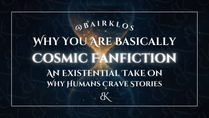On The Topic Of Anger | A Philosophical Writing Rant
- Bair Klos

- Feb 20
- 4 min read
"Anyone can become angry—that is easy.
But to be angry with the right person, to the right degree,
at the right time, for the right purpose,
and in the right way—that is not easy.”
— Aristotle

Hello, readers!
This isn’t a typical blog post—I just wanted to share some thoughts I’ve been mulling over lately—specifically anger. I found this topic to be vastly interesting, perhaps you will too.
Anger is something curious to me. Personally, I am not someone who is prone to anger. I often find the emotion unnecessary unless I am witnessing an injustice. Even when I rationalize and remind myself that all emotions are valid, it is not an emotion that comes easily to me—and that sparked a curious realization:
Anger is not a stand alone emotion.
Anger is almost always a secondary emotion, triggered by something deeper—fear, injustice, neglect, rejection, insecurity, or sadness. It’s a response to something beneath the surface.
The only time I can think of where anger might be unprovoked is when someone’s hormones are out of balance (hello, mid-cycle mood swings). But even then, the cause isn’t nothing—it’s biological.
So, this got me thinking: If anger is always tied to something deeper, what does that mean for our characters? And how can we use it to add nuance to our writing?
Using Anger to Add Depth to Your Characters
1.) What Does Anger Reveal About Your Character?
A character’s anger—or lack thereof—can speak volumes about their personality, experiences, and wounds.
Are they quick to anger? Maybe they grew up constantly having to defend themselves because no one ever stood up for them.
Are they slow to anger? Maybe they were taught that their emotions were invalid, so they learned to bottle them up.
Do they believe anger is dangerous? Perhaps they had a toxic or abusive upbringing and now suppress their anger out of fear of becoming like their abuser.
Do they lash out easily? That could indicate a deep-seated insecurity, where defensiveness is a survival mechanism.
Anger isn’t just an emotion—it’s a window into a character’s backstory and psychological makeup.
2.) Anger as a Catalyst for Character Growth
If a character suppresses their anger, their journey might be about learning to express it in a healthy way.
If a character acts out in rage, their growth could involve learning restraint and emotional control.
Example: A warrior character who views anger as a weapon might learn that unchecked rage makes them reckless. Over time, they master the art of channeling their fury into something productive—be it strategy, wisdom, or leadership.
Letting a character grapple with anger—learning when to use it, when to let it go—can make for powerful development arcs.
Using Anger in Your Storytelling
Character Development
Anger can be a defining trait or a hidden vulnerability. Ask yourself:
What specifically triggers their anger?
How do they express it—explosively, coldly, silently?
How does it shape their relationships and choices?
Example: In a fantasy novel, a protagonist’s rage over betrayal could push them to uncover hidden strengths—or blind them to dangerous truths.
Plot Progression
Anger can be a turning point in the story. A character’s outburst or moment of rage might escalate conflicts, expose secrets, or lead to life-altering decisions.
Example: A character who finally stands up to their oppressor might spark a rebellion—or destroy an alliance.
Dialogue & Conflict
Angry dialogue can create intense, memorable moments between characters. It can be emotional, raw, and reveal hidden wounds.
Example: A heated argument might not be about what’s being said but what’s left unsaid—unresolved resentment, old betrayals, or deeper fears.
Emotional Resonance
Readers connect with emotions. Anger, when portrayed authentically, can make a story more immersive. Instead of just saying “he was furious,” describe how it feels.
Example: Instead of “She was angry,” try “Her hands clenched into fists, nails biting into her palms. A slow heat crawled up her neck, making her vision blur at the edges.”
Thematic Exploration
Anger can tie into larger themes like justice, revenge, oppression, or redemption.
Example: A revenge-driven protagonist might struggle with the morality of their rage, questioning whether their anger is justified or consuming them.
Concluding Thoughts
Anger is a powerful emotion that can drive characters to extraordinary actions and create stories that captivate readers. By understanding the root cause of anger, we can craft characters that feel real, layered, and emotionally compelling.
So next time you write an angry character, ask yourself:
What is the real source of their anger?
What does it reveal about their past?
How does it shape their journey?
Anger is never just anger—it’s a story waiting to be told.
I'd love to hear your thoughts on the post and writing anger. Drop a comment below!
Happy writing!
—Bair✍︎
Disclaimer: Please note that this blog post contains affiliate links, which means I may receive a referral commission at no extra cost to you. This support helps keep my website up & running, and me writing! Thanks so much for your support!
Want to stay up to-date on get exclusive updates and insights on future projects, book launches,
writer and reader resources, FREE literature,
writing freebies, and a more?
Sign up for my Newsletter!
Find more helpful writing tips on the rest of my blog.
Struggling to get your word count in? Check out my writing podcast!
Need a new notebook? Check out my hand-bound books!
Support the blog on Ko-fi!
Check out My Writer & Reader Merch Store
Like this post?
Share the link on your social media or
pin the image below to your Pinterest board!




















Comments